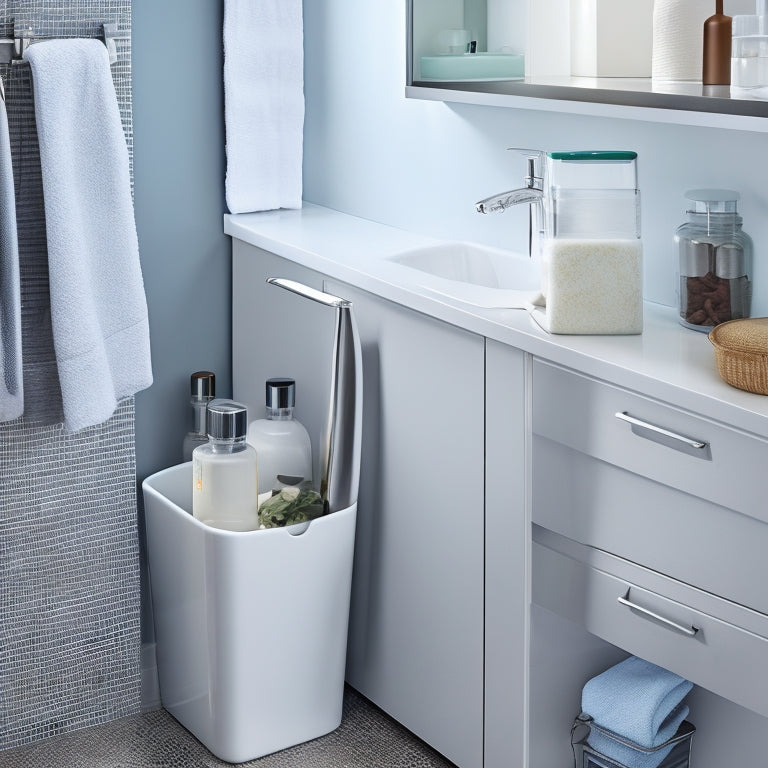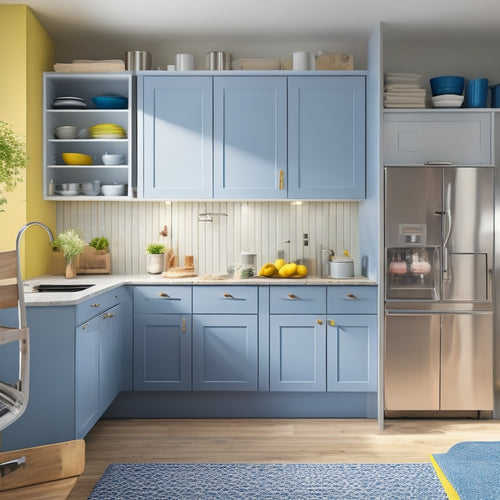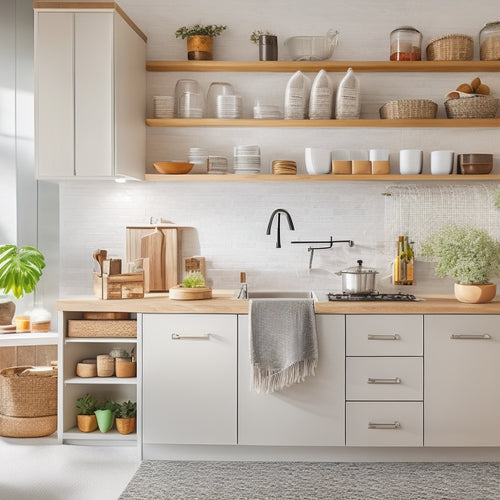
Revamp Your Under-Sink Setup Like a Pro
Share
To revamp your under-sink setup like a pro, start by evaluating your space and categorizing existing items, taking note of cabinet dimensions and unique features. Curate your contents by grouping similar items together and identifying what can be relocated or removed. Accurate measurements are essential for selecting suitable storage solutions that maximize vertical space and facilitate efficient retrieval. By prioritizing items based on frequency of use and strategically placing storage solutions, you can create a seamless and efficient under-sink setup. With a thorough understanding of these principles, you'll be well on your way to achieving a clutter-free and functional kitchen.
Key Takeaways
• Assess your under-sink space by evaluating existing items, noting cabinet dimensions, and ensuring a clutter-free area for maximum functionality.
• Curate cabinet contents by categorizing items, grouping similar ones together, and identifying what can be relocated or removed for a functional arrangement.
• Take precise measurements of items and storage spaces to select containers that fit seamlessly and avoid frustration.
• Opt for smart storage solutions like tiered shelving, pull-out baskets, and adjustable dividers to maximize vertical space and maintain order.
• Prioritize items based on frequency of use and strategically place storage solutions to create a seamless and efficient under-sink setup.
Assess Your Under-Sink Space
Before revamping your under-sink setup, it is essential to assess the space by thoroughly examining the current contents and layout to identify areas of improvement.
Evaluate existing items, categorize them, and determine what needs to stay and what can be relocated. This step allows you to organize efficiently, ensuring a clutter-free space that maximizes functionality.
Take note of the cabinet's dimensions, obstructions, and any unique features that may impact your organization strategy. By doing so, you'll avoid purchasing unsuitable containers and create a tailored system that suits your needs.
A well-assessed space sets the stage for a successful under-sink makeover, saving you time and frustration in the long run.
Curate Your Cabinet Contents
With a clear understanding of the under-sink space's layout and dimensions, the next step is to thoughtfully curate the cabinet contents by evaluating and categorizing the items that will remain, ensuring a functional and organized arrangement.
To declutter efficiently, begin by sorting items into categories, such as cleaning supplies, pipes, and miscellaneous items. Categorize effectively by grouping similar items together, like all cleaning products or plumbing tools. This process helps identify what can be relocated or removed, making way for a more streamlined setup.
Take Precise Measurements
Accurately measuring the dimensions of the items intended for under-sink storage is essential to selecting containers that fit seamlessly and optimizing the available space. Measure accurately, avoid frustration – it's a mantra to live by when revamping your under-sink setup. Precision matters, plan ahead, and you'll be rewarded with a stress-free organizational system.
| Measurement | Item | Dimension |
|---|---|---|
| Width | Cleaning Bottle | 6 inches |
| Height | Stackable Bin | 10 inches |
| Depth | Under-Sink Shelf | 18 inches |
Select Smart Storage Solutions
Optimizing under-sink storage requires selecting containers and organizers that not only fit the measured space but also facilitate efficient retrieval and use of the stored items. This is where space saving strategies and organizational hacks come into play.
To achieve a seamless setup, consider the following:
-
Tiered shelving: Maximize vertical space with stackable bins and shelves, allowing easy access to frequently used items.
-
Pull-out baskets: Install sliding drawers or baskets to corral small items, keeping them hidden from view but easily retrievable.
-
Adjustable dividers: Use customizable dividers to separate cleaning supplies, personal care items, and other categories, maintaining a sense of order and calm.
Optimize Your Under-Sink Layout
Cabinet geometry and item categorization inform the strategic placement of storage solutions, ensuring a harmonious coexistence of form and function within the under-sink space.
To optimize your under-sink layout, prioritize items based on frequency of use and allocate space accordingly. Utilize vertical space by stacking containers or incorporating pull-out drawers, maximizing storage capacity without sacrificing accessibility.
Incorporate hanging organizers, such as hooks and baskets, to capitalize on often-wasted areas like the back of the cabinet door or the underside of the sink.
By thoughtfully allocating space and leveraging vertical and hanging storage, you'll create a seamless and efficient under-sink setup that makes cleaning and maintenance a breeze.
With a well-planned layout, you'll be the master of your under-sink domain!
Frequently Asked Questions
How Do I Prevent Moisture Buildup Under My Sink?
To prevent moisture buildup under your sink, consider installing sink liners and moisture traps, which absorb excess water and reduce humidity, thereby minimizing the risk of mold and mildew growth, ensuring a dry and hygienic environment.
Can I Use DIY Organizers or Are Custom Ones Better?
When deciding between DIY organizers and custom ones, consider budget constraints and aesthetic preferences. DIY options can be cost-effective, but may lack precision fit and style. Custom organizers, while pricier, offer tailored solutions that harmonize with your space's unique needs and design.
What's the Best Way to Store Hazardous Cleaning Supplies?
In a busy household, storing hazardous cleaning supplies demands attention to Chemical Segregation and Safety Labels. For instance, separate corrosive substances from flammable ones, and label each container with warning signs, ensuring a safe and organized storage solution that prevents accidents.
How Often Should I Clean and Maintain My Under-Sink Organizers?
To maintain ideal under-sink organization, incorporate daily routines, such as quick wipe-downs and tidying, and schedule seasonal refreshes every 3-4 months to reassess storage needs and purge expired or unnecessary items.
Are Adjustable Organizers Necessary for Under-Sink Cabinets?
The age-old dilemma: are adjustable organizers necessary for under-sink cabinets? The answer lies in the pursuit of flexible design and space maximization, where adaptability meets precision, ensuring a tailored fit that accommodates evolving storage needs.
Related Posts
-

Smart Storage Solutions for Small Kitchen Spaces
You're struggling to find space in your small kitchen, but don't worry, smart storage solutions can help. Start by ut...
-

Create Your Own Kitchen Countertop Organizer System
To create your own kitchen countertop organizer system, start by evaluating your available counter space, identifying...

